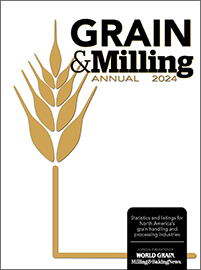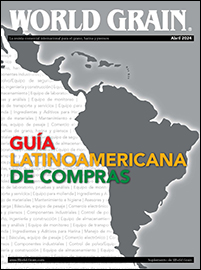Photo by Adobe Stock.
“An increasingly favorable weather backdrop in the southern hemisphere pressured global market sentiment in the past month,” the International Grains Council (IGC) said in its Grain Market Report at the end of February. “And despite occasional support from firm U.S. domestic and export demand, the IGC GOI sub-Index eased by around 4%.”
“The market was weighed by improved growing conditions in South America, particularly in Argentina following an earlier period of heavy rains and flooding,” the IGC noted. “USDA’s February WASDE report placed U.S. end-season stocks higher than anticipated and was also mildly bearish, but downside was trimmed by support from domestic crush data and firm international demand for competitively priced U.S. supplies. With basis levels steady, export quotations retreated by $16, to $398 fob Gulf.
“Although progress was mixed across key states, the advancing harvest weighed on prices in Brazil, with fob quotations (Paranagua basis) falling by 4%, to $397 fob. Similarly, Up River offers in Argentina eased by 3%, to $392 fob, on beneficial growing conditions, despite some uncertainty about the scale of earlier weather-related crop losses.”
In its Agri Commodities Monthly report for March, Rabobank was bullish on soybeans.
“Soybean prices are expected to be somewhat supported by the continued need to remain at a large premium versus corn and also due to a continued view of the smaller-than-anticipated increase in U.S. planted acreage,” Rabobank said. “We have adjusted our price forecast for nearby CBOT soybeans 4% lower month on month, to reflect growing South American production expectations, but our forecast remains above the current forward curve.”
Rabobank explained that, with yield potential across both countries increasing on improved crop conditions, Argentine and Brazilian soybean production was expected to exceed 164 million tonnes.
Source: World Bank
“Market attention now turns to the task of moving commodities to export channels and export demand, given increased confidence of a record crop across South America. If South American shipments of beans or meal are delayed, this could prove bullish for U.S. demand and prices.”
Rabobank was less positive about palm oil.
“Production recovery and relatively subdued demand continue to put downward pressure on palm oil prices,” it said.
Rabobank quoted the Malaysian Palm Oil Board as reporting that Malaysia’s crude palm oil production had declined by 1.4% on the month, to 1.26 million tonnes.
“Despite lower monthly production, they were still 20.7% higher year on year, giving affirmation that palm oil production yield has started to recover from previous El Niño impact,” Rabobank said.
Indonesian palm oil production fell to 2.86 million tonnes in January.
“We expect palm oil output in both countries to improve in the near months, while full recovery in production is expected from the second half of 2017,” Rabobank said. “Palm oil prices are also under pressure due to relatively poor demand. Malaysian February 2017 palm oil exports declined 14% month on month, to 1.11 million tonnes, while Indonesian palm oil exports only increased by 1.7% month on month, to 2.72 million tonnes in January 2017.”
Rabobank said the threat of El Niño was still uncertain. It quoted the U.S. National Oceanic and Atmospheric Administration as saying that there is a 50% chance of El Niño returning in the second half of 2017.
“It is currently still too early to tell whether we are actually heading towards an El Niño,” Rabobank said.
The IGC reported ICE canola futures broadly steady month on month, “lightly underpinned by technical buying and slow farmer selling. Additional support stemmed from talk of tightening supplies, but gains were capped by falls in soybeans and world vegetable oil markets, together with sluggish end-user demand tied to weaker crush margins,” it said.







